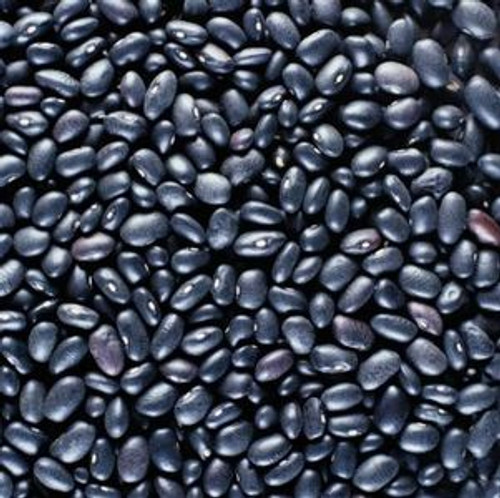Type: Open Pollinated/Heirloom
Relative Days: 85
Plant Height: 18-24"
Seed Color: Black
Life Cycle: Annual
Characteristics:
Black Turtle is a compact bush bean that produces high yields of small, dark purple-black seeds with rich, earthy flavor and dense, meaty texture. Also known as Black Beans, Frijoles Negros, or Turtle Soup Beans, this South American heirloom was introduced to the U.S. in the late 1700s and remains a staple for dry bean markets. Plants are well adapted to a range of climates and perform reliably even in northern regions. The beans are popular for use in soups, stews, vegetarian dishes, and traditional Latin American cuisine. Their deep color also reflects a naturally high anthocyanin content.
Snap Beans (Phaseolus vulgaris) and Lima/Butter Beans (Phaseolus lunatus)
Snap and lima beans come in two main growth types: bush and pole (also called runner). There are also “half-runner” varieties, which exhibit growth habits between the two primary types.
- Bush beans grow into compact plants about 1 to 2 feet tall and produce their pods in a concentrated period, which is well-suited for mechanical harvesting.
- Runner or pole beans develop long vines, typically reaching heights of 6 to 7 feet, and must be trellised. These varieties produce pods over a longer period, making them ideal for markets where manual picking is preferred, such as pick-your-own and roadside stands.
Soil
Both snap and lima beans require minimal nitrogen. Snap beans, also known as green beans, bush beans, or string beans, thrive in soils that retain moisture while allowing good air and water movement. The optimal soil pH for growth is between 5.8 and 6.6. Snap beans need consistent moisture, especially during flowering and pod formation, as lack of water can cause blossoms and pods to drop, leading to lower yield and quality. However, too much moisture increases the risk of root rot. Even if the soil isn’t ideal, it can achieve great results.
Temperature
Snap beans are sensitive to frost and need warm conditions for growth. Seeds generally germinate in soil temperatures between 60 and 80°F, with germination time ranging from 6 to 10 days, depending on the temperature. Cooler soil can slow germination and increase the risk of seedling diseases, so planting in cold soil should be avoided. Beans grow best at temperatures between 60 and 70°F but can tolerate temperatures from 55 to 80°F. Higher temperatures, especially above 90°F, can hinder pollination and cause flowers to drop.
Spacing
- Bush types: Seeded 2 - 4 inches in the row, 24-26 inches between rows at a depth of 1–1½ inches. If soil is dry in later planting, use a depth of 1½ inches.
- Runner/Pole types: Rows should be 36-48 inches apart with 6 to 8 inches between seeds. Depth should be between 1–1½ inches. If soil is dry in later planting, use a depth of 1½ inches.
Harvest
- Bush snap beans: Harvest when pods are tender and have reached the appropriate size for the variety. Since bush beans produce a concentrated crop, they can be harvested all at once. Avoid leaving beans on the plant after maturity, as pods will become tough and fibrous. “Stringless” varieties are less likely to become tough due to delayed fiber development.
- Bush lima beans: Pick when the pods are still green, but the seeds are fully developed. Test by shelling a few samples to check seed maturity.
- Runner/pole beans: Typically harvested every 3 to 5 days over a longer period to stimulate continued flowering and pod production. Regular harvesting encourages immature pods to grow. (Snap or lima)
Crop Rotation
To maintain soil health and prevent disease, avoid planting beans immediately after other legume crops like peas and soybeans.
For more information, please see links below:
- Penn State Extension - Snap Bean Production
- UCSC - Bush Bean Guide
- University of Tennessee - Bean Production
Downloadable Copy:
Please click here to download a printable version.




